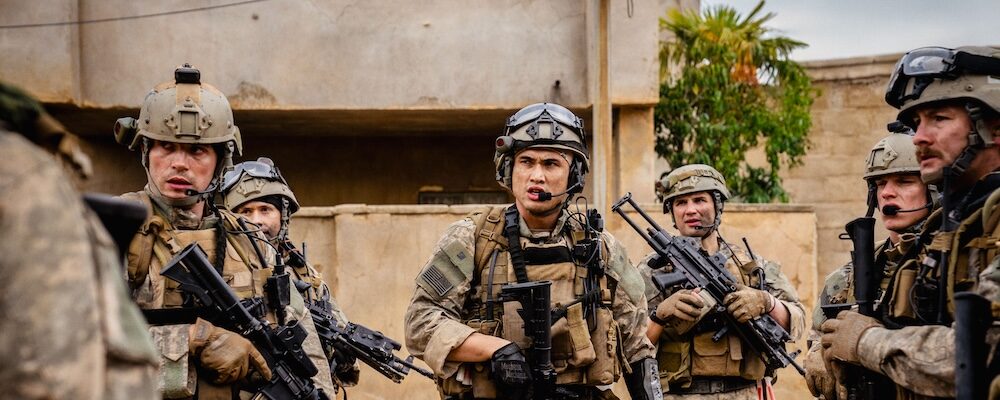Alex Garland’s ‘Warfare’ Evokes Every Searing Detail of Ray Mendoza’s War Battle Memories
Alci Rengifo
As a sensory experience, Alex Garland’s “Warfare” is one of the most visceral recent examples of cinema’s capacity to place a viewer within a moment. Garland co-directs and wrote the script with Ray Mendoza, a former Navy SEAL who worked as a combat adviser on the director’s last film, the eerily speculative “Civil War.” When Garland inquired about Mendoza’s time in Iraq, he found enough inspiration for the two to work on what is now this film. Aside from some sly moments worth discussing later, like a lot of cinema revolving around the Iraq War, any political commentary tends to remain neutral. The urgency of “Warfare” resides in wanting to recount the details of what Mendoza remembers.
The setting is 2006 and the U.S. occupation of Iraq has been going on for three years. Mendoza was involved in an operation that was part of U.S. efforts to control Ramadi, the capital of Anbar Province. A platoon that includes Ray (D’Pharaoh Woon-A-Tai of “Reservation Dogs”) makes its way into a two-story building, relegates an Iraqi family to a bedroom and takes positions. During the tedious boredom that follows, we get to know scant details about the various soldiers including tobacco-chewing sniper Elliott (Cosmo Jarvis), Frank (Taylor John Smith) and Captain Erik (Will Poulter). Outside, there are hints of insurgents moving about. Radio commands warn that there has been a call for “jihad” against the American troops, meaning people don’t like being invaded. When the platoon attempts an exit, all hell breaks loose when an IED explosion initiates an assault by rebels and the SEALs are forced back into the house to wait for support and fight their way through.
Since the Vietnam War film has proven wrong the great French auteur François Truffaut, who claimed it was impossible to make an antiwar film because movies will always make combat look fun. There’s not much that’s “fun” about “Warfare” or even “entertaining” in the conventional sense. Garland, usually a director of hypnotic style, and Mendoza are after a “you are there” feeling. Compared to other combat films, it’s rather microcosmic, relegating its action to a house that gradually becomes a smoke-filled den of hectic violence. There isn’t any of the grandiose plotting or character writing from something like Ridley Scott’s “Black Hawk Down,” though like that movie, violence itself isn’t romanticized. What a bomb or shrapnel does to the human body is presented in startling, searing reality. Trained, tough men become moaning, terrified people when left bleeding on the floor.
Even with its visceral sense of combat, “Warfare” can be termed more of a snapshot than a full narrative. Slice off some of its running time and it can work as an effective short film. Garland’s controversial “Civil War” last year worked best like a journalism film speculating about the violence we associate with foreign countries erupting here. “Warfare” could almost be a documentary. The gritty cinematography by David J. Thompson never goes for picturesque framing, opting instead for chaos. When fighter jets fly low over the city as a “show of force,” the sound mix is enough to nearly ring your ears. The only real objective amid the mangled bodies begging for morphine and soldiers taking fire is to get out of this trap inch by bloody inch. Good actors like Charles Melton disappear behind their roles barking orders while trying to save whoever is left.
The Vietnam generation famously grappled with its experience artistically through powerful films like “Apocalypse Now,” “Platoon” and “Casualties of War” that had the edge of the counterculture. Soldiers were portrayed as diverse personalities arguing about the war itself, wondering if it was worth all the lives lost. Maybe because millennials were different and the Iraq War’s aims so hard to define as the Bush White House sought to remake the Middle East, facing it through cinema has been an altogether different experience. Nobody in this film is given time to talk about much. The Iraqis are also a rather blank slate, including the ones who work with the U.S. troops as interpreters. This is not to imply Garland and Mendoza have no empathy. Theirs is not some macho nationalist anthem like “American Sniper.” An Iraqi woman screams at the troops during one brutal hail of explosions “why?” We sense the filmmakers are not in disagreement with her reaction.
As a visceral exercise, “Warfare” is an impressive piece of work. Skillfully directed and written with the authenticity of Mendoza’s memories. Gradually, we may see deeper reflections on what the war meant, something essential now in light of new bouts of horrific conflicts initiated and dragged out by leaders all too eager to spill someone else’s blood. Many films based on true stories tend to end with real footage of photos of its subjects. The way Garland and Mendoza use that tool here is emotionally stirring and admirably, they do include a portrait of the Iraqi family. The real questions swirling in Garland’s mind might be best seen in a moment where he quietly lingers over the destruction left behind of the neighborhood. Nobody who lived through it will ever forget what happened. As effective as this film can be, when Garland focuses ever so briefly on the Iraqis, we have to wonder when a movie about this war will be made from their point of view. Mendoza’s story is still worth telling and this film momentarily makes us live it.
“Warfare” releases April 11 in theaters nationwide.

